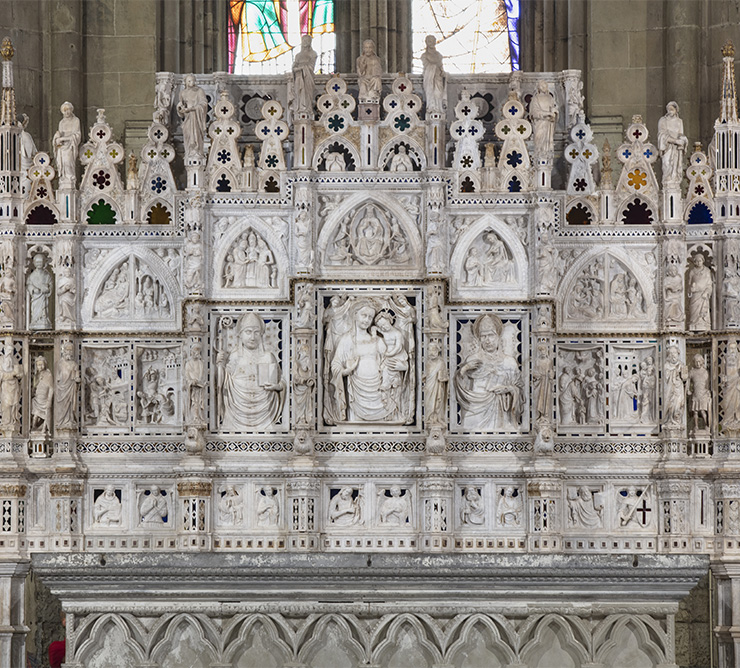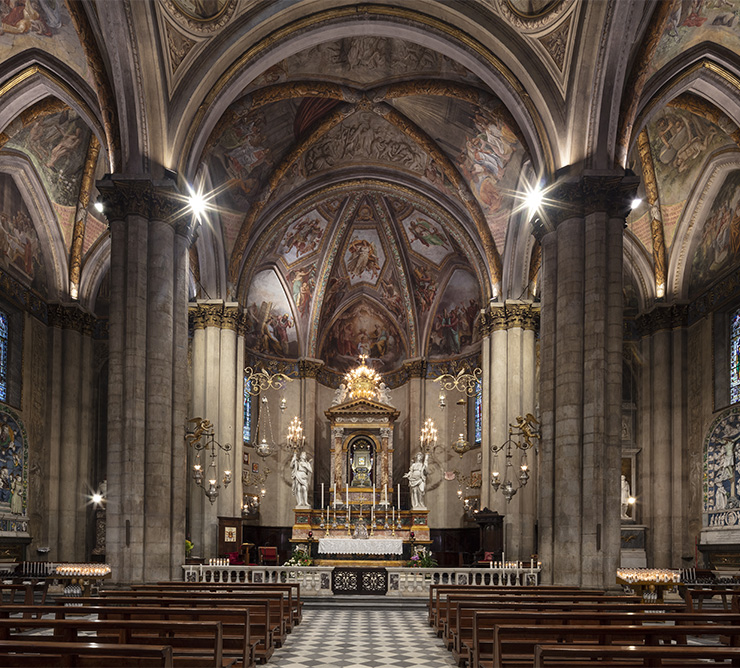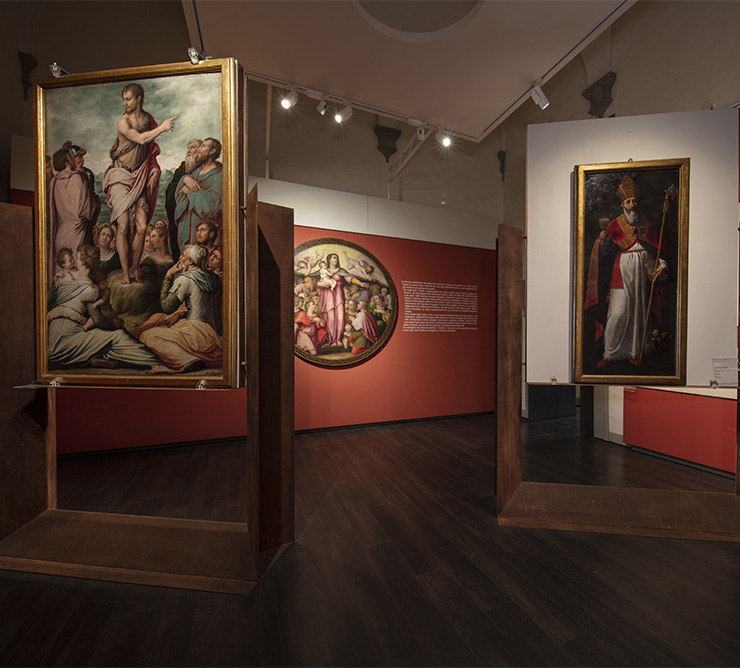The Cathedral, which is dedicated to Saints Peter and Donato, is located on Piazza del Duomo. This majestic Christian building contains authentic art treasures and important testimonies of faith inside its harmonious Gothic architecture. In front of it stands the Bishop's Palace, which contains the Diocesan Museum of Sacred Art.
The Cathedral stands dominating the square at the top of a large staircase that encloses the temple on two sides. The exterior facade, which remained unfinished, was defined in its current arrangement between 1900 and 1914 to a design by Dante Viviani. The ensemble... more
The Cathedral stands dominating the square at the top of a large staircase that encloses the temple on two sides. The exterior facade, which remained unfinished, was defined in its current arrangement between 1900 and 1914 to a design by Dante Viviani. The ensemble, in which there is no lack of Art Nouveau-style details, is enlivened by an articulated sculptural apparatus. The interior, with three naves without a transept, is characterised by a polygonal apse. A masterpiece of glass art is the cycle of seven stained glass windows by Marcillat, painted in two stages between 1516 and 1524. He is also responsible for the Biblical Stories painted in the vaults of the first three bays of the main nave and the first bay of the left aisle. Monumental is the High Altar complex. The Ark of San Donato, which holds the mortal remains of Arezzo's patron saint and second bishop of the city, attracts the gaze for the brightness of its marble, its size and the exquisiteness of its design. In the left aisle, next to the door of the sacristy, one can admire a masterpiece by Piero della Francesca: the Magdalene, probably executed in 1459, while the master from Sansepolcro was in town painting the fresco cycle of the Legend of the True Cross in San Francesco. The visit to the Cathedral culminates in the Chapel of Our Lady of Comfort, which opens along the left aisle and is connected to the miracle of 15 February 1796. Begun in August of the same year, the chapel was completed in 1817 and today is the focus of strong popular devotion. Directly opposite the cathedral stands the Bishop's Palace, still the seat of the Bishop of Arezzo. It was built in the 13th century, although its current appearance dates back to the end of the 16th century, when the building was radically renovated with subsequent 17th-17th century additions. Since 2011, five rooms on the ground floor have housed the Diocesan Museum of Sacred Art, a very interesting collection of paintings, sculptures, illuminated manuscripts, wall hangings and goldsmithery from the territory of the diocese, while the first floor houses the bishop's picture gallery and the Papal Chamber, used to welcome popes visiting Arezzo. Worthy of note is the decoration of the vestibule, a small reception room that preserves a cycle of frescoes retracing the history of the ancient Diocese of Arezzo, where the main saints and the most important places of worship in the territory are commemorated.
lessCATHEDRAL:
from Monday to Saturday
from 10:00 a.m. to 6:00 p.m.
Sundays and Public Holidays
from 1.30 p.m. to 6 p.m.
DIOCESAN MUSEUM:
from 1st April to 31st October
daily from 10:00 a.m. to 6:00 p.m.
from 1st November to 31st March
Friday / Sunday from 10:00 a.m. to 1:00 p.m. and from 2:00 p.m. to 5:00 p.m.
26 December / 8 January 2023
daily from 10 a.m. to 6 p.m.
(last entry half an hour before closing time)
By car:
Arezzo can be easily reached from Florence or Rome via the Autostrada del Sole (A1 Milan-Naples), exiting at the Arezzo tollgate. From here it is about 10 km to the city centre. Then there are the state roads: the SS 73 coming from Valdichiana, Siena, Grosseto and Sansepolcro and the SS 71, Umbro-Casentinese, coming from Cortona, Lake Trasimeno, Perugia.
By train:
The Arezzo railway station is located along the Bologna-Rome line. The station is served by daily high-speed and Intercity connections to Florence, Rome and the whole of Italy.

The Ark of San Donato, which holds the mortal rests of Arezzo's patron saint, attracts the visitor's attention due to the brightness of its marble, its size and the exquisiteness of its design. The complex consists of three parts: the altar completed before 1289, the marble altarpiece finely worked in bas-relief bristling with spires and pinnacles and placed on the altar in the second half of the 14th century, and the large ark containing the relics of the Saint and other martyrs of Arezzo. A work of several sculptors, who finished it by 1375, it portrays the Madonna and Child in the centre, while at the sides are St Gregory Pope and St Donato whose body, together with the bodies of St Antilla and other saints, is located under the altar. On the sides of the three central figures are scenes from the life of St Donato, while in the upper register are scenes from the life of the Virgin Mary.
St Donato, born in Nicomedia and moved to Rome as a child, later took refuge in Arezzo to escape persecution against the Christians. He became a bishop and died here, suffering martyrdom in 304 under Diocletian. The oldest hagiographic texts narrate his beheading and the secular cult that the city has paid to its patron, associating him with the title of martyr since the 8th century. For the miracles he has performed and his intense work of evangelisation, he is venerated not only in Arezzo and other Tuscan municipalities, but also in numerous locations in Italy and abroad. His feast day is celebrated on 7 August.
less
The chapel, dedicated to Our Lady of Comfort, was built between 1796 and 1823 to a design by the Florentine architect Giuseppe Del Rosso, and is a notable example of neo-Gothic architecture with neo-classical decoration. After passing through the imposing wrought-iron gate, we are ushered into a sumptuous environment, rich in variegated marble, gilding and vast frescoed surfaces. The majestic room, divided into three naves, was built following a miracle on 15 February 1796.
The small terracotta image that can be seen on the chapel's high altar, depicting the Virgin Mary's bust, was found inside a tavern in the city, near Porta San Clemente. The majolica depiction of the Virgin Mary, blackened by soot from a coal cooker that was under the effigy, was, according to some witnesses, seen to whiten and glow, and the earthquake tremors, which scourged the city in those days, ceased. Bishop Niccolò Marcacci officially declared the prodigy, which was followed by other miracles attributed to the sacred image, which has been called Virgin Mary of Comfort ever since, having consoled the population terrified by the earthquake. The devotion of the people is very much alive, and in 1993 it was declared by John Paul II as the Patron Saint of the Diocese.
less
The centre of Vasari's works in the Museum is well represented by the processional banner painted by the artist for the Compagnia dei Peducci in 1549 and consisting of two highly refined canvases depicting the Preaching of the Baptist and the Baptism of Jesus. The two canvases, characterised by the delicacy of the colours and shading, as well as the sober naturalism of the figures and the profound spirituality of the scene, are unquestionably among the best painted by this Master. Exhibited by the same artist is a tondo depicting the Virgin Mary of Mercy, dated 1557, formerly the sky of a sumptuous canopy that was carried in procession.